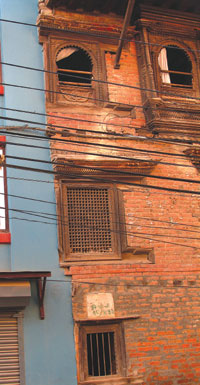|
|
| THE OASIS AND THE SPRAWL: From the air, Patan Darbar Square looks like a dream plonked in the middle of a concrete jungle. |
It's not quite time to get out the party hats yet, but Kathmandu Valley is in damage control mode. After four ignominious years on the World Heritage Sites in Danger list, the Valley, with its distinctive collection of historic spiritual sites, has been taken off.
Kathmandu has been on the World Heritage Sites list for 28 years, for being home to the darbar squares of Kathmandu, Patan, and Bhaktapur, Swoyambhunath, Boudhanath, Pashupatinath, and Changunarayan.
The danger to some of these sites comes from one feature of many of these sites that makes them so attractive: their near-complete integration into the daily lives and physical environments of people who live around them.
As the capital becomes more urbanised, and growing immigration puts increased pressure on new and old focal points, the areas around these old sites too are changing. Older houses are being demolished in favour of towering cement structures that obliterate the well-planned vistas most old areas had. Fast food and cheap clothing vendors have sprung up where buildings could not, and places like Patan Darbar Square are subject to greater physical strains than before.
Along with UNESCO's warning came 55 recommendations, some of which were taken on board swiftly by the Kathmandu Metropolitan City and the Department of Archaeology. Vehicles were no longer allowed into the monument areas, stone markers were placed around the sites, hoarding boards and curio shops were removed from the premises, and maps of the sites marking them as World Heritage Sites were put up.
This was enough for UNESCO and the International Council for Monuments and Sites (ICOMOS) to take the Valley off the list earlier this month, citing commendable efforts to preserve its heritage in the face of outstanding urban development.
This doesn't mean we can celebrate, though, says Rohit Ranjitkar of the Kathmandu Valley Preservation Trust. "We mustn't let being off the endangered list make us complacent," he argues.
Many problems remain to be tackled. "Kathmandu and Patan darbar squares are allowing vehicles in again, not to mention the night markets. Boudha is blocked from all sides by buildings," explains Riddhi Pradhan of the Nepal Heritage Society, which does everything from restoration and environmental improvement to awareness-raising walks.
|
|
| RUBBING SHOULDERS: Some exquisitely restored traditional residences, like the Shrestha House guest house, are cheek-by-jowl with modern monstrosities. |
The night markets, paradoxically promoted by the very municipalities responsible for the preservation of heritage sites, are a real problem in Kathmandu and Patan darbar squares. "Anything can happen with these markets around," says Saraswati Singh of the Patan Darbar Heritage Committee. "Smoke from the food stalls stains the walls, garbage is everywhere, and there is always the fear of a fire breaking out. These are holy sites, not public hawking spaces, bulletin boards, or eateries."
Singh also points to the disturbing trend of using these darbar squares for public gatherings and mass meetings that can and often do turn violent, endangering the sites. "There was a notice recently forbidding demonstrations in darbar squares," says Ranjitkar, adding bitterly, "But who pays attention? The prime minister himself recently attended a large Nepali Congress rally at Basantapur."
To be sure, in many parts of the city things are slowly changing, and new buildings are making at least an attempt to fit the ethos of old Kathmandu, with traditionally-tiled facades. Prime Minister Koirala aside, support is also coming from the interim government, which has put heritage site conservation on its Priority 1 list and is giving it a large enough budget, says Rajesh Mathema at the World Heritage Section of the Department of Archaeology. The DoA will monitor an Integrative Management Plan drawn up with UNESCO and to be implemented by KMC. The plan deals largely with the private buildings around the sites, but also includes public awareness programs.
Getting the general public to appreciate the inherent value of heritage sites is essential, especially with regard to the private buildings around the heritage sites, say heritage consultants and urban planners. "Public awareness is paramount," says Riddhi Pradhan . "Whatever we've accomplished so far is all due to public awareness." Pradhan points to the conservation success in Bhaktapur, which she attributes to the love local residents have for their surroundings.
"We take our heritage for granted," says Ranjitkar. "People need to learn the value of our culture and heritage. Only that will make them stop these destructive activities."




